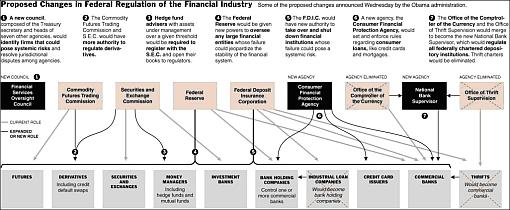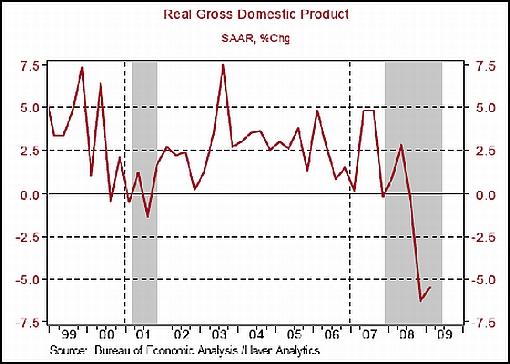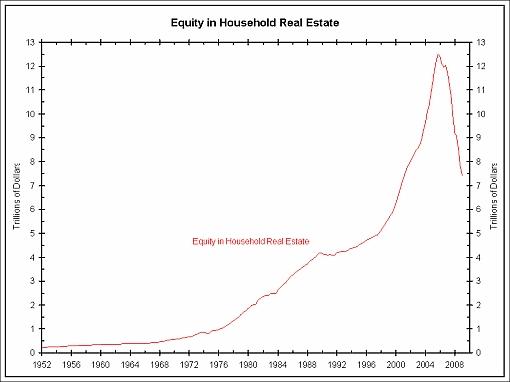Global Business Sentiment Improves Inline with Stock Market Trends
Stock-Markets / Financial Markets 2009 Jun 28, 2009 - 10:04 AM GMT While investors’ hopes of an economic recovery might have got ahead of reality, the cartoonists continually reminded us of worrisome issues …
While investors’ hopes of an economic recovery might have got ahead of reality, the cartoonists continually reminded us of worrisome issues …
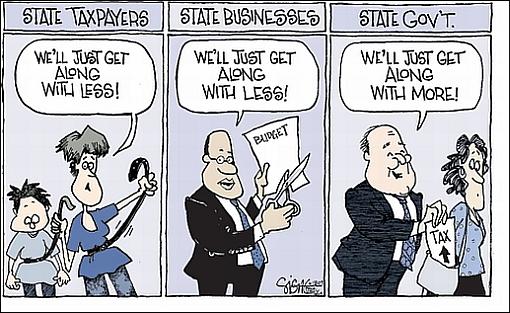
Source: Signe Wilkinson, Washington Post, June 18, 2009.
The past week’s performance of the major asset classes is summarized by the chart below - a mixed bag so to speak.
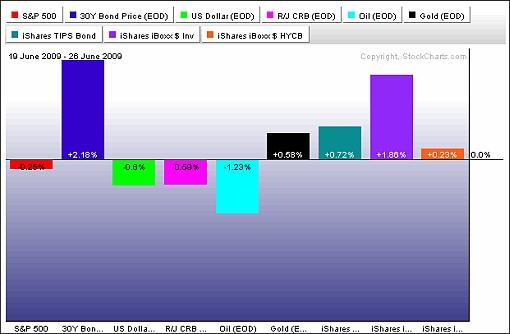
Source: StockCharts.com
A summary of the movements of major stock markets for the past week, as well as various other measurement periods, is given below. Although many indices saw little change, some short-term swings occurred in between.
Click here or on the table below for a larger image.
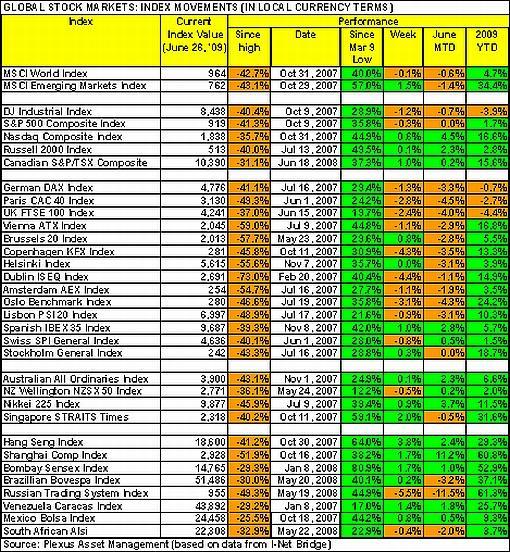
Stock market returns for the week ranged from top performers Côte d’Ivoire (+7.5%), Hong Kong (+3.8%), Taiwan (+3.5%), Argentina (+3.3%) and Bangladesh (+3.0%), to Ghana (-12.7%), Egypt (-11.1%), Nigeria (-10.7%), Cyprus (-6.6%) and the United Arab Emirates (-6.1%) at the other end of the scale. (Click here to access a complete list of global stock market movements, as supplied by Emerginvest.)
John Nyaradi (Wall Street Sector Selector) reports that as far as exchange-traded funds (ETFs) are concerned, the leaders for the week included iShares MSCI Taiwan Index (EWT) (+6.6%), Market Vectors Gold Miners (GDX) (+5.9%) and iShares MSCI Hong Kong (EWH) (+4.4%). On the other side of the performance spectrum, laggards were centered in the energy sector, including United States Gasoline (UGA) (-5.9%) and iShares Dow Jones US Oil and Gas Exploration (IEO) (-5.2%).
Next, a tag cloud of all the articles I read during the past week. This is a way of visualizing word frequencies at a glance. Key words such as “bank”, “financial”, “economy”, “Fed”, “growth” and “prices” featured prominently.
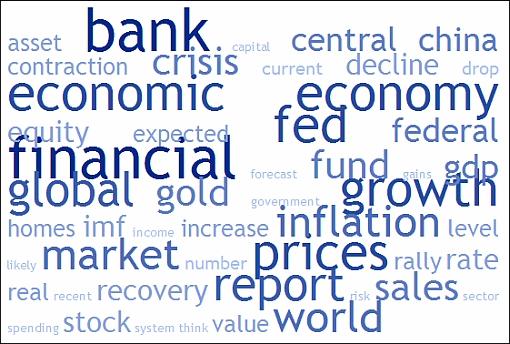
Back to the stock markets: the key moving average levels for the major US indices are given in the table below. The indices are all trading above the 50-day moving average, but whereas the S&P 500 Index, Nasdaq Composite Index and Russell 2000 Index are also trading above their respective 200-day lines, the Dow Jones Industrial Average and the Dow Jones Transportation Index are still below this key line. In order for a major uptrend to manifest itself, an upturn in the 200-day average itself also needs to take place.
Click here or on the table below for a larger image.

For more discussion on the direction of stock markets, see my recent posts “Richard Russell: Competitive devaluations to spur on gold“, “Video-o-rama: Potpourri of bulls and bears“, “Global stock market declines - threatening moving averages“, “Bill King: Deflation trade back in vogue” and “Technical talk: Seasonal trends less bullish“. (And do make a point of listening to Donald Coxe’s webcast of June 26, which can be accessed from the sidebar of the Investment Postcards site.)
Economy “Businesses are growing steadily less dour. Global business sentiment improved last week to its best level since last October. Confidence remains consistent with a continued global recession, but the downturn is moderating,” said the latest Survey of Business Confidence of the World conducted by Moody’s Economy.com. “Businesses are notably more optimistic regarding the outlook towards year’s end; expectations regarding the outlook are as strong as they have been since summer 2007 when the financial crisis began.”
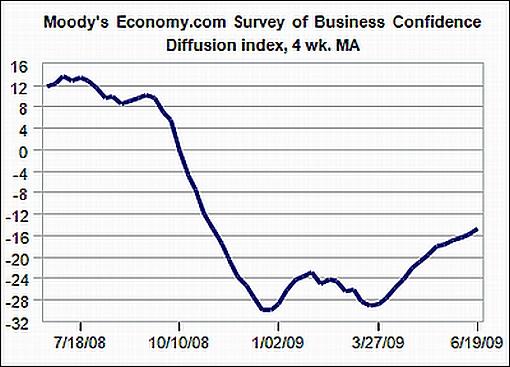
Source: Moody’s Economy.com
A snapshot of the week’s US economic data is provided below. (Click on the dates to see Northern Trust’s assessment of the various data releases.)
June 26 • Strong increase in Personal Income is temporary, Consumer Spending on track for decline in Q2
June 25 • Q1 real GDP minor upward revisions, outlook for Q2 unchanged • Jobless Claims - temporary setback or reversal of improvement?
June 24 • Sales of new homes - mixed bag of news • Durable Goods Orders gather momentum, but shipments remain weak
June 23 • Existing home sales - inventories are declining
June 22 • Capital stock of the US economy - history
The Federal Open Market Committee (FOMC) announced no change to monetary policy following its meeting on Wednesday. The communiqué said the Committee expected to keep the Fed funds rate target in the 0-0.25% range “for an extended period”. However, the comments regarding the current economic situation were somewhat more optimistic, saying that “the pace of economic contraction is slowing”.
The Fed’s quantitative easing programs remained unchanged, targeting the purchase of mortgage-backed securities ($1.25 trillion), agency debt ($200 billion) and long-dated Treasury securities ($300 billion).
Summarizing the US economic outlook, Asha Bangalore (Northern Trust) said: “We are projecting a contraction of real GDP in the second and third quarters and a small increase in the final three months of 2009. The unemployment rate is expected to peak in the first half of 2010, while inflation will not present problems until 2011/2012.”
Week’s economic reports
Click here for the week’s economy in pictures, courtesy of Jake of EconomPic Data.
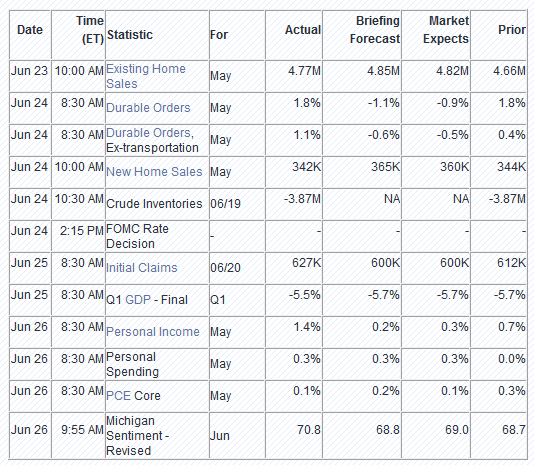
Source: Yahoo Finance, June 26, 2009.
Across the pond the European Central Bank (ECB) will make an interest rate announcement (Thursday, July 2), while in the US economic highlights for the week include the following:
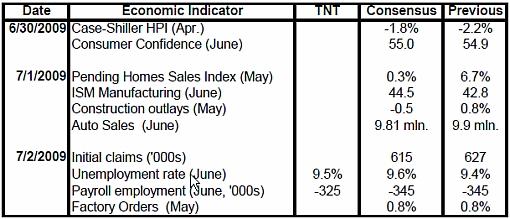
Source: Northern Trust
Click here for a summary of Wachovia’s weekly economic and financial commentary.
Markets
The performance chart obtained from the Wall Street Journal Online shows how different global financial msarkets performed during the past week.
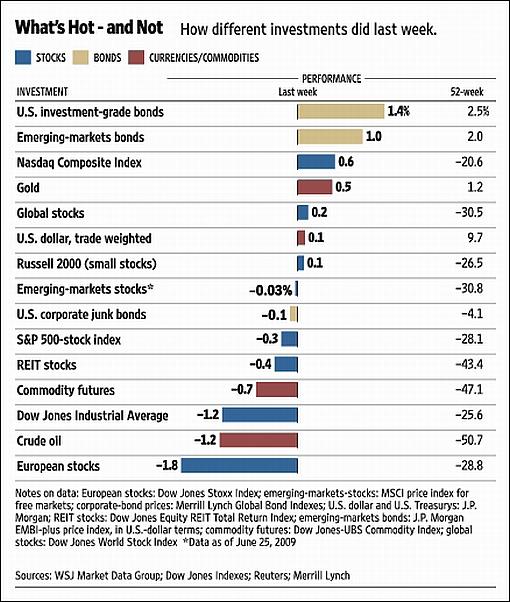
Source: Wall Street Journal Online, June 26, 2009.
“Never spend your money before you have it,” said Thomas Jefferson (hat tip: Charles Kirk). And when you do have it, let’s hope the news items and quotes from market commentators included in the “Words from the Wise” review will help you to invest wisely.
That’s the way it looks from Slovenia’s delightful capital, Ljubljana - pronounced “Loob-li-yana” and meaning “the beloved” - where I will be spending the next week. (For short comments – maximum 140 characters – on topical economic and market issues, web links and graphs, you can also follow me on Twitter by clicking here.)

Source: Dilbert.com, June 26, 2009 (hat tip: Barry Ritholtz).
Casey’s Charts: Lesson from a 38-year track record of bailouts “In the wake of Penn Central filing for bankruptcy, America’s largest rail company at the time, Congress passed the Rail Passenger Service Act of 1970 and Amtrak was born. The new federal monopoly was expected to be self-sufficient by 1974.
“Today, 38 years of federal subsidies and over $33 billion tax dollars later, the company has yet to turn a profit. So what is Congress’s solution?
“Throwing the dysfunctional enterprise $13 billion more tax dollars over the next five years, plus another $1.3 billion towards infrastructure and security.
“If the bureaucrats’ ongoing experiment with Amtrak is any indication of GM or Chrysler’s future, then American taxpayers are in for a world of hurt.
“Growing government intervention and control of the economy is a big trend now in motion.”
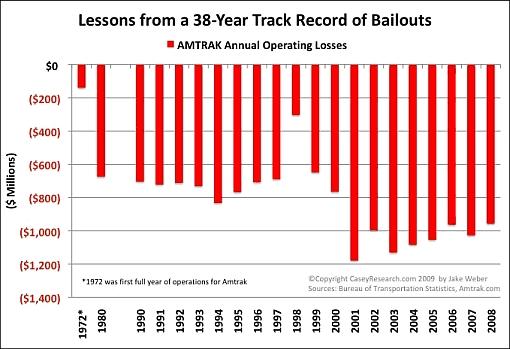
Source: Casey’s Charts, June 25, 2009.
The New York Times: Some lawmakers question expanded reach for the Fed “No sooner had President Obama proposed a new regulatory road map for the country’s financial system on Wednesday than senior lawmakers expressed reservations about one of the plan’s central elements - to broadly expand the reach of the Federal Reserve to regulate financial risk across the entire system.
“Mr. Obama said that the plan would protect consumers, impose new restraints on financial behemoths and guard against the murky practices that caused the market crisis.
“‘A culture of irresponsibility took root from Wall Street to Washington to Main Street,’ he said in a speech to industry executives and senior officials in the East Room of the White House. ‘A regulatory regime basically crafted in the wake of a 20th century economic crisis - the Great Depression - was overwhelmed by the speed, scope and sophistication of a 21st century global economy.’
“Administration officials said that much of the proposal would not require Congressional action and would be adopted by regulators. These include raising the amount of the financial cushion that institutions must hold against losses, setting new conflict of interest rules for credit rating agencies and imposing new requirements that banks hold on their own books a percentage of the mortgages they issue to discourage the marketing of abusive or ill-suited loans.
“But the most significant elements would require new laws. Minutes after Mr. Obama’s speech, the two Democratic chairmen whose committees will put their own imprint on the plan vowed to complete legislation by the end of this year, but only on Congress’s terms.
“Senator Christopher Dodd of Connecticut, chairman of the Senate Banking Committee, said the central bank’s failure to be a tough-minded regulator over the last decade had left him and other lawmakers without ‘a lot of confidence in the Fed at this point’. One of the criticisms is the Fed’s failure to stop the sale of subprime mortgages and other dangerous home loans that helped cause the financial crisis.
“Mr. Dodd said giving the Fed a new role as overall risk regulator might also compromise its independent status and conflict with its mandate to control inflation and manage the supply of money by setting interest rates.
“Representative Barney Frank of Massachusetts, who until recently was publicly supportive of an expanded role for the Fed, said a significant number of lawmakers have raised concerns and that it would probably be one of the harder issues to resolve.
“Some large financial institutions are expected to lobby against giving the Fed more power to police the system. They fear that the central bank would significantly raise the amount of capital they must hold against losses, which would reduce their profitability and make them less competitive with smaller companies that have lower capital rates.”
Source: Stephen Labaton, The New York Times, June 22, 2009.
Bloomberg: Bernanke defends his record on Bank of America talks “Federal Reserve Chairman Ben Bernanke defended the central bank against lawmakers’ charges it put undue pressure on Bank of America Corp. to take over Merrill Lynch & Co. last year at the height of the financial crisis.
“‘The Federal Reserve acted with the highest integrity throughout its discussions,’ Bernanke said today in testimony to the House Oversight Committee. He said actions by the Fed and other central banks last year helped avert a financial meltdown that would have produced a ‘Depression-like environment’.
“Legislators are trying to determine whether Bernanke overstepped his authority in pressuring Bank of America to complete the purchase of Merrill. Bernanke’s record on the issue and lawmakers’ reactions may also figure in whether he will be reappointed by President Barack Obama, and in debates on overhauling the Fed’s powers and responsibility.
“‘These are the kind of questions that need to be answered before the president makes his decision,” Elijah Cummings, a Maryland Democrat and member of the committee, said in a Bloomberg Television interview earlier today.
“One is to allow large banks, but to take steps that will protect the economy if in fact one comes to the brink of failure,” an approach currently proposed by Treasury, Bernanke said. “The other possibility is to restrict the size of banks. I think it is legitimate to discuss both options.”
Source: Craig Torres and Scott Lanman, Bloomberg, June 25, 2009.
John Authers (Financial Times): Great Recession “After deep confusion, elements of agreement are emerging. Official economists and investors in different countries that have been affected in different ways by the crisis agree on some points.
“Wednesday’s economic forecast from the Organisation for Economic Co-operation and Development expressed the emerging orthodoxy as well as any.
“Anyone reading a year ago what the OECD had to say would have been horrified. It said the nadir for the developed world had not been reached and a recovery would be so weak that unemployment in the US and western Europe would exceed 10% and stay there.
“Yet anyone reading it during the worst months of the crisis late last year would have been relieved. The OECD is arguing that a Great Depression induced by a banking collapse has been averted; we will have a Great Recession instead.
“The OECD said that extremely aggressive policy centred on cheap money should stay in force. Only a few weeks ago, this was contentious; now it is accepted.
“A disparate group of central banks with different priorities seem to agree. The US Federal Reserve this week refused to offer any guidance on when it would exit from its loose monetary policy; the European Central Bank added liquidity to money markets much more aggressively than had been expected; and it seems the Swiss National Bank pushed down its own currency.
“So there is the consensus: disaster averted, no strong recovery as the developed world relies on China for its growth, and no quick end to extreme policy measures.
“This consensus is consistent with another consensus, that the nadir for share prices in March was ‘the’ bottom. If the consensus is right, the March bottom should hold. Let us hope it is right.”
Source: John Authers, Financial Times, June 25, 2009.
Bloomberg: World Bank says global economic recession to deepen “The World Bank said the global recession this year will be deeper than it predicted in March and warned that a flight of capital from developing nations will swell the ranks of the poor and the unemployed.
“The world economy will contract 2.9%, compared with a previous forecast of a 1.7% decline, the Washington-based lender said in a report today. Growth will be 2% next year, down from a 2.3% prediction, the bank said.
“The bank, formed after World War II to fund health and development projects in poor countries, said that while a global recovery may begin this year, impoverished economies will lag behind rich nations in benefiting. The lender called for ‘bold’ actions to hasten a rebound and said the prospects for securing aid for the poorest countries were ‘bleak’.
“The bank is more pessimistic than its sister organization, the International Monetary Fund. The IMF, which is forecasting a global contraction of only 1.3% this year and growth of 2.4% in 2010, said June 19 that it plans to revise estimates ‘modestly upward’.
“The lender’s view also contrasts with that of billionaire hedge fund manager George Soros, who on June 20 told Polish television that the worst of the global financial crisis ‘is behind us’.
“The World Bank cut its forecast for the US this year, calling for a 3% drop in the world’s biggest economy, after predicting a 2.4% contraction in March.
“Japan’s gross domestic product will shrink 6.8%, more than the previous prediction of a 5.3% decline, the lender said. The euro area’s economy may shrink 4.5%, compared with the previous estimate of a 2.7% contraction.
“Global trade may drop by 9.7%, compared with a March forecast of a 6.1% decline.
“Economic growth in the developing world will be 1.2%, the World Bank said, scaling its outlook back from 2.1%. Developing nations in eastern Europe and Central Asia will be some of the hardest hit, the revised forecasts show. The region’s economy is likely to shrink 4.7% this year, down from the 2% decline projected in March.”
Source: Timothy Homan, Bloomberg, June 22, 2009.
MoneyNews: Soros - worst of global crisis behind us “The worst of the global economic crisis is over, multi-billionaire financier George Soros told Polish news channel TVN24 on Sunday urging the creation of international regulations to oversee global markets.
“‘Decidedly the worst (of the crisis) is already behind us,’ said Soros, a 78-year-old Hungarian-born American with Jewish roots.
“He did not elaborate but went on to stress the uniqueness of the current economic turmoil.
“‘This is not like previous crises but marks the end of an era. The system to date had been based on the false assumption that markets can independently regain their equilibrium and that the system is self-correcting,’ he explained.
“He also said the regulation in the economy should be aimed at controlling market bubbles.
“‘We need international regulations to retain international markets. This won’t be easy … If we won’t be able to do this … than globalization, as we now know it, will fall apart,’ he said.
“To deal with the current crisis he said ‘the state must step in, give guarantees to financial institutions and increase government spending’, adding that he supported anti-crisis measures undertaken by the US administration.
“Since that could create a risk of hyperinflation he said the state must diminish its role once the credit system is restored.”
Source: MoneyNews, June 22, 2009.
Financial Times: ECB pumps €442 billion into banking system “The European Central Bank on Wednesday pumped hundreds of billions of euros in one-year loans into the eurozone’s weakened banking system, making record amounts of emergency finance available in a bid to unlock credit markets and revive the region’s economies.
“The move came as the US Federal Reserve pushed back against expectations of an early rise in US interest rates.
“In a dramatic step dubbed ’stimulus by stealth’ in financial markets, the ECB lent €442.2 billion for 12 months to more than 1,100 banks at its current benchmark interest rate of 1%.
“The high demand for the funds, in what was the ECB’s first ever auction for one-year loans, reflected a growing realisation by the banks that emergency funding may not be available again on such favour-able terms.
“The central bank’s action could boost the eurozone’s recovery prospects by lowering market interest rates and creating more scope for banks to lend to the private sector.”
Source: Ralph Atkins, Krishna Guha and David Oakley, Financial Times, June 24, 2009.
David Hauner (Banc of America Securities-Merrill Lynch): EEMEA growth intact “The growth model of Emerging Europe, Middle East, and Africa (EEMEA) remains alive in spite of the financial and economic crisis, believes David Hauner, head of emerging EMEA economics at Banc of America Securities-Merrill Lynch.
“Offering a marked contrast to the widely-held view of EEMEA as a prime victim of the crisis, he argues that some countries may even experience an acceleration in growth.
“Mr Hauner acknowledges that the credit-dependent region will be challenged by deleveraging. ‘Capital inflows and GDP growth may not be as abundant as in the boom - but that proved unhealthy anyway.
“‘Still low income levels mean EEMEA will keep on playing catch-up. With low wages, competitive exchange rates and proximity to European markets, the beleaguered central and eastern European (CEE) region will remain a prime destination for foreign investment.’
“He believes combined EEMEA GDP growth over the next ten years is still likely to average 3-4.5% a year - and some countries might even enjoy better growth in the next decade than in the last.
“‘The prime candidate is Turkey which could finally live up to its potential thanks to greater macro stability. South Africa may also improve as the government is aggressively investing in infrastructure. But Russia and CEE will probably slow as the easy productivity gains from post-socialist restructuring peter out.’”
Source: David Hauner, Banc of America Securities-Merrill Lynch (via Financial Times), June 23, 2009.
Jim O’Neill (TimesOnline): We need Brics to build the world economy “Last week the four leaders of the Bric countries (Brazil, Russia, India and China) formally met together in their first summit. I have been asked a number of questions about the event. First, did I really think this would ever happen? Second, would it have happened if I hadn’t created the acronym? Third, what real purpose did it serve, and fourth, where do I think the Bric path is heading?
“I’ve also been asked a couple of supplementary questions: why these four countries and why not Indonesia, Turkey or indeed Iran? And do I think the global credit crisis has changed the picture from our prediction a number of years ago, that the combined GDP of the Bric economies could exceed that of the G7 countries before 2040?
“Let me try to answer each of these questions, starting with the last. For the past 12 months, we have believed that it is conceivable that China’s GDP could become as large as the GDP of the United States by 2027, i.e., in less than 20 years and, as a result of that, the combined GDP of the Bric countries could be as big as the G7.
“Part of the reasoning behind this view is simply that, in the first seven years since I created the acronym, three of the four Bric countries, China, India and, importantly, Russia have all grown considerably more than we had assumed. The fourth, Brazil, grew a bit less but, encouragingly, in the year running up to the crisis and since the worst of it has calmed, Brazil is showing signs of its trend growth rate rising. The other reason, which is increasing our confidence, is that most of the Bric countries have had a ‘better’ crisis than their developed counterparts.
“Importantly, given that they are the most populous countries, both China and India could almost be said to be enjoying a ‘good crisis’. In the case of India, consensus forecasts for 2009 and 2010 are that it will grow by close to 6%, a rate double that of the so-called Hindu decades of 3%. Not bad at a time when the world economy is likely to have actually declined.
“In China, I find myself increasingly arguing that the crisis has been really good for China’s sustainable growth, as it has been sufficiently shocking for policymakers in Beijing to realise that the days of massive export growth are over. By undertaking huge fiscal and monetary stimulus, as well as beginning serious social security reform and development, China appears committed to an era where development will be led by growth in domestic demand.
“As a result, we forecast that China will still manage to grow by more than 8% this year despite weak exports. We forecast that, in 2010, domestic demand will accelerate to more than 12%, allowing GDP to grow in excess of 10%. Both countries could quite conceivably grow by close to 10% for many years at the same time.
“Russia, undoubtedly the weakest of the four, is too dependent on oil, but now that oil prices have started to rise again, Russian growth will recover and only requires it to grow by an average of 3-4% a year to justify its place in Brics.
Click here for the full article.
Source: Jim O’Neill, TimesOnline, June 23, 2009.
Bespoke: Country GDP growth “Below we highlight 2009 estimated GDP growth for 21 countries. As shown, only China and India are expected to actually grow in 2009, while the other countries are expected to contract. China’s 2009 GDP growth estimate is at 7.66%, while India’s is at 4%. The US is closer to the top of the list than the bottom with an estimate of -2.49%. It ranks only behind Canada among other G7 countries. Japan and Germany are expected to see the biggest contraction in GDP in 2009 at -6.61% and -6.06% respectively. The UK is at -3.74%, Russia is at -2.77%, and France is at -2.75%.”
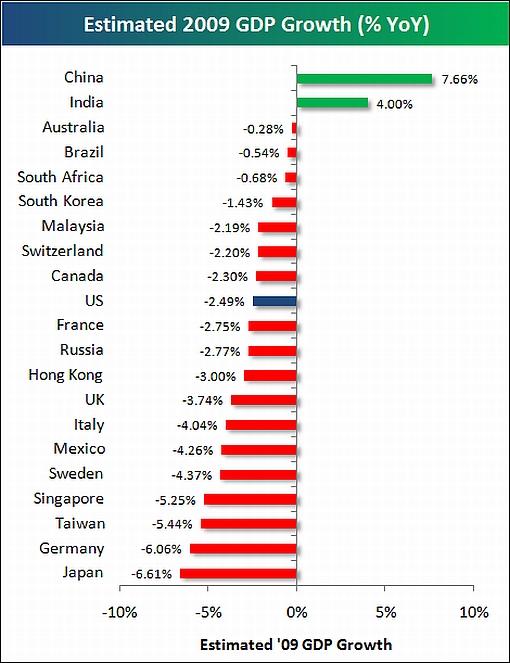
Source: Bespoke, June 26, 2009.
Bespoke: Country inflation rates “Below we highlight a big bar chart showing the most recent inflation rates for 77 countries. The average unweighted inflation rate for all of the countries is 4.11%. Fifty-nine countries are currently seeing prices rise versus a year ago, 14 are seeing prices decline, and 4 are flat. Venezuela has the highest inflation rate at 27.7%, followed by Kenya, Iran, Ukraine, Pakistan, Guatemala, and Russia.
“Ireland is seeing the most deflation with a year over year decline in prices of 4.7%. China has the third biggest decline in prices at -1.4%, while the US is right behind at -1.3%. Whether or not you use this chart to make any investment decisions, it does provide a good look at where each country stands in regards to price movements.”
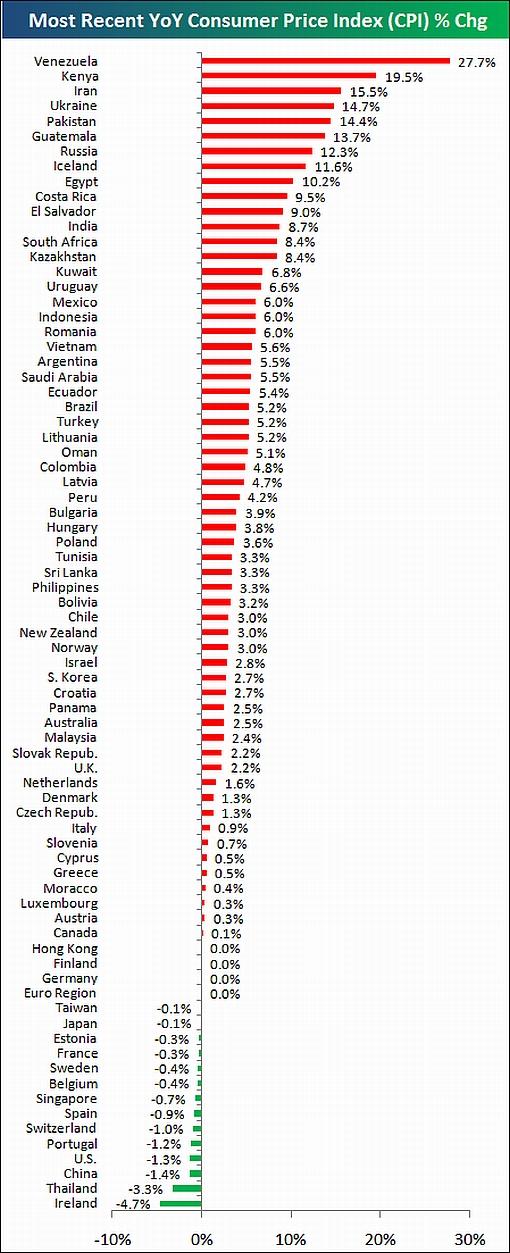
Source: Bespoke, June 23, 2009.
MoneyNews: Faber - 20% inflation coming “Contrarian guru Marc Faber predicts we’ll soon see inflation of 10-20%.
“The numbers will rise so fast because the government ‘massively’ understates the country’s inflation rate, Faber said.
“To get a true reading he advises ditching core inflation numbers, including the Consumer Price Index. ‘It’s a lie what they publish,’ Faber told CNBC.
“‘If you underweight education costs, and if you underweight health care costs, then you come to a totally different result,’ he said.
“Since the creation of the Federal Reserve Bank in 1913, the dollar has lost 95% of its purchasing power, Faber said. ‘It took 100 years to lose 95% (but) I think the next 94% loss in purchasing power will happen very quickly,’ he said.
“In such a volatile market, Faber thinks the safest place to invest is in equities or assets, even real estate. ‘I’m not very bullish about real estate prices in the US, but I’d rather be in real estate than in 30-year US bonds,’ he said.
Julie Crawshaw, MoneyNews, June 25, 2009.
Stuart Thomson (Ignis Asset Management): Deflation lives “Reports of the death of deflation have been greatly exaggerated, says Stuart Thomson, economist at Ignis Asset Management.
“‘The number of mentions of deflation in the press has fallen to the lowest since the collapse of Lehman Brothers,’ he says. ‘But if creating inflation was as simple as the markets suggest, the Japanese authorities would have done it years ago.’
“Mr Thomson says Japan failed to create inflation in the 1990s because inflationary expectations remained very low due to wage deflation caused by globalisation.
“‘Western economies, with the exception of Germany, largely escaped these pressures because heavy consumer borrowing and asset price inflation maintained wage growth.’
“However, Mr Thomson says rising unemployment in the major industrialised economies, together with deleveraging and widening output gaps, is expected to exert downward pressure on wage inflation over the next few years.
“‘We believe the cost of capital must fall so as to match lower labour costs and provide the necessary investment to create new industries that will absorb this surplus labour, close output gaps and cause wage rates and inflation to rise on a sustained basis.
“‘Disinflation over the past quarter century has driven the outperformance of government bonds. This is unlikely to be repeated over the next 25 years - but over the next 3 years, deflation is a greater risk than inflation.’”
Source: Stuart Thomson, Ignis Asset Management (via Financial Times), June 25, 2009.
Bill Fleckenstein (MSN Money): Will economy’s “green shoots” wither? “FedEx last Wednesday tempered the enthusiasm of folks on ‘green shoot’ watch. While stating its belief that the economy had hit bottom, the company also said it had no ‘visibility’ to predict future earnings or any expectations of a real uptick in business.
“Much of this economic green shoot talk has centered on slight improvements in still-weak/sloppy business conditions. But a lot of that has been a function of companies restocking inventory after the collapse in business at the end of last year and the start of this one.
“That, coupled with money printing and the stock market rally, fed on itself and caused a lot of people to get excited about economic prospects improving drastically by the year-end.
“But now that the market rally has stalled, negative macroeconomic and corporate news could easily precipitate a reassessment of this whole green-shoots-growing-into-a-beanstalk idea that a recovery has begun.
“This means the Federal Reserve’s predicament will become even clearer. Given the path it has chosen, the Fed will have to print even more money. That’s likely to mean upping its quantitative easing at some point, as Treasury yields have ratcheted up and mortgage rates have followed suit.
“Weighing in on the subject, a knowledgeable source I often refer to as the ‘Lord of the Dark Matter’ told me: ‘Make no mistake, it is a total disaster, with most banks now offering 30-year fixed (mortgages) in the mid- to high-5% range, and then only for the best FICOs. Then again, it was tremendously naive or, more likely, arrogant in the first place to assume that you could indefinitely run a public sector borrowing requirement of 13% of GDP and keep mortgage rates down at a level that induces a massive, permanent refi boom.’
“In any case, due to the ramifications (both present and future) of the Fed’s money printing, it has now resorted to the jawbone policy. The Fed thinks that by talking tough enough, it can boost its credibility and get bonds to rally (lowering rates), thus wriggling itself out of the box. But given the damage wrought by its own hands, that will be hard to do.
“Thus, somewhere in the not-too-distant future, the Fed is liable to find itself back in the position of needing to create more stimulus. (To the extent that stocks are weak, you can be sure that the Fed’s tough talk will evaporate.)”
Click here for the full article.
Source: Bill Fleckenstein, MSN Money, June 22, 2009.
Asha Bangalore (Northern Trust): FOMC Meeting - Fed chooses to leave plans to purchase securities unchanged “The Fed held the federal funds rate unchanged (0-0.25%) as expected. The modifications to the policy statement were consistent with the incoming economic reports indicating that the pace of decline in activity has slowed.
Economy in general, June 24, 2009 “‘Information received since the Federal Open Market Committee met in April suggests that the pace of economic contraction is slowing.’
April 29, 2009 “‘Information received since the Federal Open Market Committee met in March indicates that the economy has continued to contract, though the pace of contraction appears to be somewhat slower.’
“The Fed appears to be less concerned about deflation compared with the situation in April, given the modification of the statement today.
Inflation/deflation, June 24, 2009 “‘The prices of energy and other commodities have risen of late. However, substantial resource slack is likely to dampen cost pressures, and the Committee expects that inflation will remain subdued for some time.’
April 29, 2009 “‘In light of increasing economic slack here and abroad, the Committee expects that inflation will remain subdued. Moreover, the Committee sees some risk that inflation could persist for a time below rates that best foster economic growth and price stability in the longer term.’
“The federal funds rate is expected to hold steady for an extended period as indicated in the statement today: ‘The Committee will maintain the target range for the federal funds rate at 0-1/4% and anticipates that economic conditions are likely to warrant exceptionally low levels of the federal funds rate for an extended period.’
“The Fed left its quantitative easing programs intact without expansions, for now. The policy statement reiterated the size of the programs targeted at purchasing mortgage-backed securities ($1.25 trillion), agency debt ($200 billion), and long-dated Treasury securities ($300 billion).”
Source: Asha Bangalore, Northern Trust - Daily Global Commentary, June 24, 2009.
Financial Times: Fed begins slow exit from intervention “Even as Ben Bernanke on Thursday faced a bruising grilling on Capitol Hill over the Bank of America-Merrill Lynch takeover, the Federal Reserve took the first steps towards curbing its emergency support for the financial system.
“Senior Fed officials said the timing of the announcement was driven by the need to co-ordinate with foreign central banks involved in currency swap lines with the Fed - and not related in any way to the hearing.
“Nonetheless, the coincidence highlights the pressures on Mr Bernanke, as the central bank moves from aggressive easing to putting policy on hold, and contemplates an exit strategy. The timing is sensitive for Mr Bernanke, whose term as Fed chairman expires early next year.
“Thursday’s announcement means the Fed is starting to consider exit questions, with emergency credit and liquidity programmes likely to be unwound slowly, before the central bank eventually raises interest rates.
“The central bank extended its financial market support programmes - including swap lines with 14 global central banks - due to expire in October to February, but trimmed them back very slightly.
“It said it was scrapping a never-used programme, the money market investor funding facility, and scaling back two others. The Fed will reduce the maximum size of its term securities lending facility (TSLF) to $75 billion from $200 billion plus options, and the maximum size of its term auction facility (Taf) to $500 billion from $600 billion.
“While leaving open the option of expanding the programmes if needed, the Fed said it anticipated that TAF funding ‘will gradually be reduced further’.
“Unless inflation expectations move sharply against the Fed, it will probably raise rates only once the unwinding of these extraordinary programmes is well under way.”
Source: Krishna Guha, Financial Times, June 25, 2009.
Bespoke: Michigan Confidence at highest level since January 2008 “Michigan Confidence joins the growing number of indicators that are now at or better than Pre-Lehman levels. Today’s reading of 70.8 is actually the highest since January 2008. This month’s reading is also the fourth consecutive month-over-month increase in confidence. A reading of 70.8 is still well below the monthly average of 86.8 since 1978, but it’s also nicely above the level of 55 that we saw in late 2008.”
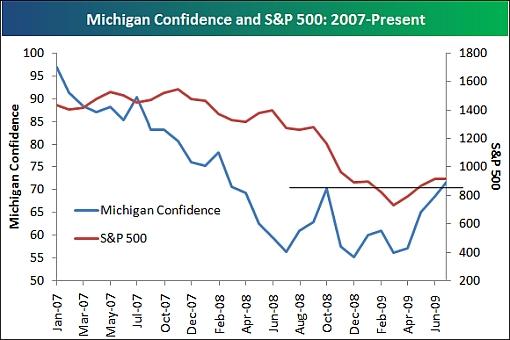
Source: Bespoke, June 26, 2009.
Asha Bangalore (Northern Trust): Q1 real GDP minor upward revisions, outlook for Q2 unchanged “Real gross domestic product (GDP) of the US declined at an annual rate of 5.5% in the first quarter of 2009, which is a small upward revision from the preliminary estimate of a 5.7% drop.
“Upward revisions of inventories, net exports, and government spending more than offset downward revisions of consumer spending and investment expenditures (both residential and non-residential) to yield an upward revision of the headline number. The final estimate also included a small upward revision of corporate profits.
“The more important issue is the outlook for the rest of 2009. We are projecting a contraction of real GDP in the second and third quarters and a small increase in the final three months of 2009. The unemployment rate is expected to peak in the first-half of 2010, while inflation will not present problems until 2011/2012.”
Source: Asha Bangalore, Northern Trust - Daily Global Commentary, June 25, 2009.
Asha Bangalore (Nothern Trust): Jobless claims - temporary setback or reversal of improvement? “Initial jobless claims rose 15,000 to 627,000 during the week ended June 19. The initial claims estimate of last week was revised to 612,000 from the prior count of 608,000. Continuing claims, which lag initial jobless claims by one week, advanced to 6.738 million from 6.709 million. The insured unemployment rate held steady at 5.0%.
“The pertinent question is if the latest jump in initial jobless claims represents a second leg of weakness in the demand for labor. The recent low of initial jobless claims is 605,000 and the cycle high is 674,000. The path of economic recovery is fraught with ups and downs. Based on other reports indicating that a nascent stabilization is underway, for now, the latest hike in jobless claims appears to be a temporary setback. Given the large fiscal stimulus that is underway and the aggressive quantitative easing put in place, it would be a surprise to see a further round of layoffs and a larger number of applicants for unemployment insurance.”
Source: Asha Bangalore, Northern Trust - Daily Global Commentary, June 25, 2009.
BusinessWeek: A lost decade for jobs “Private sector job growth was almost non-existent over the past ten years. Take a look at the horrifying chart below.
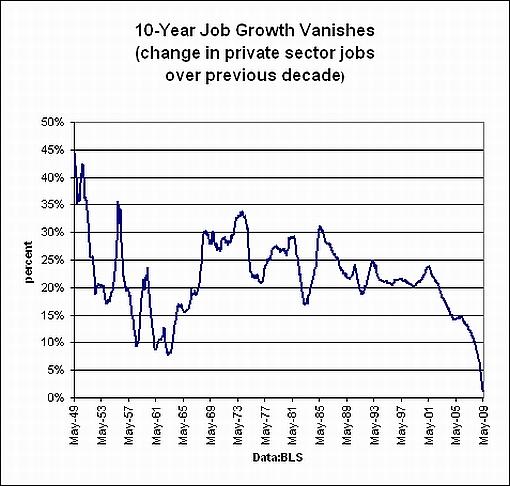
“Between May 1999 and May 2009, employment in the private sector only rose by 1.1%, by far the lowest 10-year increase in the post-depression period.
“It’s impossible to overstate how bad this is. Basically speaking, the private sector job machine has almost completely stalled over the past ten years.”
Source: Michael Mandel, BusinessWeek, June 23, 2009.
CNBC: CEOs see recession easing but still cut jobs, spending “US chief executives took a slightly less grim view of the economy in the second quarter, but still plan to cut jobs and capital spending, according to a Business Roundtable survey released Tuesday.
“The quarterly CEO Economic Outlook Index rebounded to 18.5 in the second quarter from a record low of negative 5 in the first quarter. But it was still the third-lowest reading in the survey’s six-year history.
“A reading below 50 means CEOs expect economic contraction rather than growth.
“‘What we basically see is more visibility in that we don’t see us in continued free fall,’ said Ivan Seidenberg, chairman and CEO of phone company Verizon Communications and chairman of Business Roundtable. ‘The signs appear less negative than they were last quarter, but no one is ready to suggest they are going to begin hiring to start growth.’
“Corporate chieftains still plan to cut costs for the next six months, with 51% intending to reduce capital spending and 49% expecting to cut US jobs. Forty-six percent anticipate a decline in sales.
“Those plans indicated a less grim outlook than in April, when two-thirds of CEOs were planning to cut jobs and capital spending.”
Source: CNBC, June 23, 2009.
Asha Bangalore (Northern Trust): Strong increase in Personal Income is temporary, Consumer Spending on track for decline in Q2 “Personal income moved up 1.4% in May after a 0.7% increase in the prior month. Both of these strong monthly gains reflect temporary payments arising from the provisions of the American Recovery and Reinvestment Act of 2009 (fiscal stimulus). Wages and salaries declined 0.1% in May following a 0.1% increase in April, which is more representative of the underlying economic conditions compared with the overall gains in personal income. This temporary boost will be reversed when the June report on personal income is published.
“As a result of only a moderate increase in nominal consumer spending (+0.3%) and a temporary boost to personal income, personal saving as a percent of disposable income shot up to 6.9% in May. As noted earlier, the personal saving rate should be smaller when personal income is scaled back in June but the future trajectory of saving is likely to show an upward movement in the months ahead.”

Source: Asha Bangalore, Northern Trust - Daily Global Commentary, June 26, 2009.
Asha Bangalore (Northern Trust): Durable goods orders gather momentum, but shipments remain weak “Orders of durable goods moved up 1.8% in May, matching the increase seen in the prior month. In addition to defense orders (+7.4%), bookings of aircraft (+68.1%) and gains in other components excluding autos (-8.1%) were the highlights of the report. Orders of all durable goods have increased in three out of the last four months.”
Source: Asha Bangalore, Northern Trust - Daily Global Commentary, June 24, 2009.
Asha Bangalore (Northern Trust): Sales of new homes - mixed bag of news “Sales of new single-family homes were virtually flat in May (342,000 versus 344,000 in April). Sales of new homes in March and April were revised down slightly. On a year-to-year basis, sales of new single-family homes fell 34.7% matching the decline posted in April. The largest year-to-year drop was recorded in January 2009 (-45.5%).”

“The inventory of unsold new homes is down to a 10.2-month supply versus the peak reading of a 12.4-month supply in January 2009.
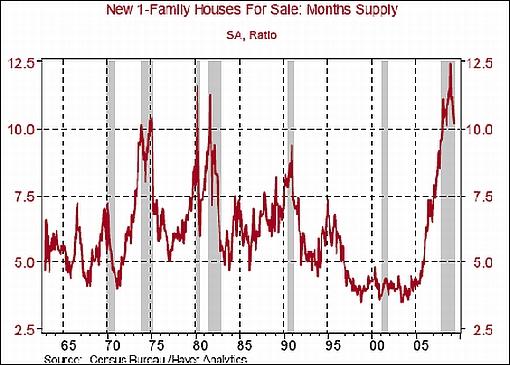
Source: Asha Bangalore, Northern Trust - Daily Global Commentary, June 24, 2009.
Asha Bangalore (Northern Trust): Existing home sales - inventories are declining “Sales of all existing homes increased 2.4% to an annual rate of 4.77 million units in May. A large part of the gains in sales was from multi-family units (+6.1%), with purchases of single-family units posting a 1.9% increase to an annual rate of 4.25 million units. Sales of existing single-family homes have risen in four of the last six months. According to the National Association of Realtors, 33% of the sales in May were distressed properties, down from 45% in April. The $8,000 tax credit for first time home buyers has helped to reduce inventories of unsold homes.

“The inventory of all unsold existing homes fell to a 9.6-month supply in May from a 10.1-month supply in April. The inventories-sales ratio for existing single-family homes was 8.9 months versus 9.1 months in April. The cycle high was an 11.3-month supply in November 2008.”
Source: Asha Bangalore, Northern Trust - Daily Global Commentary, June 23, 2009.
Bianco Research: Equity in household real estate “Fascinating chart showing the total level of equity in household real estate from 1952-2009.”
Source: Bianco Research (via The Big Picture), June 25, 2009.
TimesOnline: World’s wealthy lose faith in fund managers “Almost half of the world’s 8.6 million wealthiest investors have lost confidence in their fund manager, according to a report that lays bare how the credit crunch has damaged their personal fortunes.
“Investors’ lack of faith prompted a quarter of those with financial assets of more $1 million to pull funds from a manager or dismiss their adviser last year, according to a report by Merrill Lynch Wealth Management and Capgemini, the consultant.
“Individuals of high net worth and ultra-high net worth, who need financial assets of more than $30 million to qualify, are worth a collective $32.8 trillion, according to Merrill and Capgemini’s annual World Wealth Report, published yesterday.
“However, this is down 19.5% compared with the previous year, with the number of individuals qualifying for the high-net worth category also down, by 14.9%, according to the report.
“The report will trigger alarm bells in the City and other financial centres.
“More than 90% of those surveyed said they had lost wealthy clients last year.
“The survey, which polled more than 200 rich and super-rich investors across the globe, also found that more than three quarters of them had lost confidence in financial regulators in the wake of the credit crisis and plunging world markets.”
Source: Miles Costello, TimesOnline, June 24, 2009.
Financial Times: Fitch report highlights negative equity woe “One in 10 borrowers with an excellent credit record are trapped in negative equity, owing more on their mortgage than the value of their homes, says a report that forecasts a peak-to-trough fall in house prices of up to 35%.
“Tuesday’s report by Fitch Ratings, which is based on loan information from 2.7 million borrowers, found the highest concentration of negative equity was in Northampton, where 17% of borrowers were under water.
“There, nearly a quarter of all loans by value were secured against property that was worth less than the sums owed.
“Lenders with the highest levels of borrowers in negative equity included Northern Rock, which was nationalised in 2008, Bradford & Bingley, also rescued by the government, Birmingham Midshires, which is part of HBOS, and Alliance & Leicester, owned by Santander, the Spanish banking group.
“In its report, Fitch said negative equity could rise to 23% of all borrowers and to a third of all loans by value if its forecast of a peak-to-trough decline in house prices of 30-35% was correct.”
Source: Norma Cohen, Financial Times, June 22, 2009.
By Dr Prieur du PlessisDr Prieur du Plessis is an investment professional with 25 years' experience in investment research and portfolio management.
More than 1200 of his articles on investment-related topics have been published in various regular newspaper, journal and Internet columns (including his blog, Investment Postcards from Cape Town : www.investmentpostcards.com ). He has also published a book, Financial Basics: Investment.
Prieur is chairman and principal shareholder of South African-based Plexus Asset Management , which he founded in 1995. The group conducts investment management, investment consulting, private equity and real estate activities in South Africa and other African countries.
Plexus is the South African partner of John Mauldin , Dallas-based author of the popular Thoughts from the Frontline newsletter, and also has an exclusive licensing agreement with California-based Research Affiliates for managing and distributing its enhanced Fundamental Index™ methodology in the Pan-African area.
Prieur is 53 years old and live with his wife, television producer and presenter Isabel Verwey, and two children in Cape Town , South Africa . His leisure activities include long-distance running, traveling, reading and motor-cycling.
Copyright © 2009 by Prieur du Plessis - All rights reserved.
Disclaimer: The above is a matter of opinion and is not intended as investment advice. Information and analysis above are derived from sources and utilizing methods believed reliable, but we cannot accept responsibility for any trading losses you may incur as a result of this analysis. Do your own due diligence.
Prieur du Plessis Archive |
© 2005-2022 http://www.MarketOracle.co.uk - The Market Oracle is a FREE Daily Financial Markets Analysis & Forecasting online publication.




